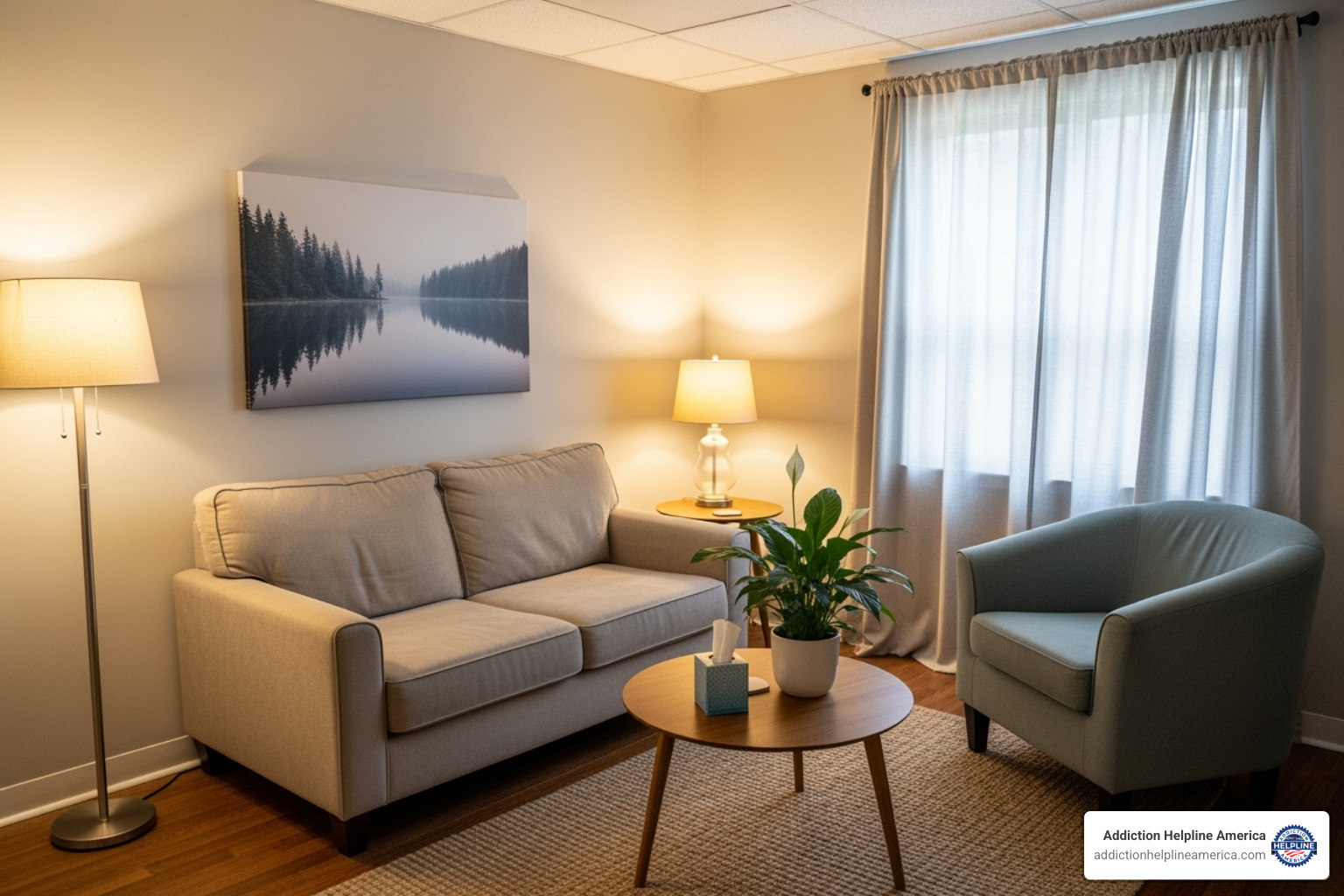Your Journey to a Healthier Life Starts Here
Free Insurance Verification
Verify Your Treatment Coverage
Verify Your Treatment Coverage
The Cost of Rehab varies widely based on treatment type, location, and services. Understanding these expenses is the first step toward making an informed decision and finding an affordable path to recovery.
Quick Overview of Rehab Costs:
For many, the inability to afford rehab is the biggest barrier to getting help. But the cost of not seeking treatment is exponentially higher. The financial toll of active addiction—from substance costs and legal fees to lost income—far exceeds the investment in recovery. Studies show that for every dollar spent on treatment, $4 to $7 are saved in drug-related crime costs, with healthcare savings reaching a 12-to-1 ratio.
The real question isn’t whether you can afford rehab, but whether you can afford to continue without it.
Options exist to make treatment accessible, from insurance and payment plans to state-funded programs. At Addiction Helpline America, we help people steer the Cost of Rehab every day. This guide will break down the costs, explain pricing factors, and show you how to access treatment within your budget.

The Cost of Rehab isn’t a single number; it’s a range of options based on the level of care you need and the duration of your stay. Just as emergency room care costs more than a routine doctor’s visit, residential treatment is more expensive than outpatient counseling. Understanding these differences helps you find the right fit for your needs and budget.
Here’s how the major treatment options compare:
| Program Type | Duration | Average Cost | Services Included (Typical) | Best For |
|---|---|---|---|---|
| Medical Detox | 3-10 days | $1,500 – $5,600 | Medical supervision, medication management, 24/7 care | Initial phase to safely manage withdrawal symptoms |
| Outpatient (OP) | 3-12+ months | $1,400 – $10,000 (3 months) | Group therapy, individual counseling, educational sessions | Individuals with mild addiction, strong support system, work/school commitments |
| Intensive Outpatient (IOP) | 30-90 days | $3,500 – $11,000 (30 days) | More frequent and intensive therapy than OP, flexible scheduling | Individuals needing more structure than OP but can live at home |
| Partial Hospitalization (PHP) | 30-90 days | $7,000 – $20,000 (per month) | Daily structured treatment (5-7 days/week), medical oversight, therapy | Step-down from inpatient, or for severe cases not requiring 24/7 residential care |
| Inpatient/Residential | 30-90+ days | $5,000 – $80,000+ (per stay) | 24/7 supervision, accommodation, meals, comprehensive therapy, medical care | Severe addiction, co-occurring disorders, unstable home environment |
| Sober Living Homes | Varies | $1,500 – $2,000 (per month) | Structured, drug-free living environment, peer support, accountability | Post-rehab support for continued sobriety and reintegration |
Let’s dig into what these numbers mean for your wallet.
Medical detox is the first step for many, managing withdrawal symptoms safely. Costs range from $250-$800 per day, with a typical 5-day stay costing between $1,500 and $4,000.
Outpatient programs (OP) allow you to live at home while attending treatment. A three-month program typically costs between $1,400 and $10,000.
Intensive Outpatient Programs (IOPs) offer more treatment hours per week (9-20) than standard OP. Expect to pay between $3,500 and $11,000 for 30 days.
Partial Hospitalization Programs (PHPs) provide day-long treatment similar to inpatient care but without the overnight stay. PHPs cost between $7,000 and $20,000 per month.
Inpatient residential treatment is the most comprehensive option, where you live at the facility. A 30-day program ranges from $5,000 to $20,000, while 60- to 90-day programs can run from $12,000 to $60,000. The full spectrum for residential care is $5,000 to $80,000+.
Sober living homes are a post-treatment option for continued support, typically costing $1,500 to $2,000 per month.
While the national average Cost of Rehab is around $13,475, this figure is skewed by shorter programs. A more typical 30- to 60-day residential stay averages closer to $50,469. The wide range reflects the personalized nature of addiction treatment.
California is a popular recovery destination, with over 2,000 treatment centers serving nearly 100,000 people annually.
For residential treatment of 30 days or more, California averages $56,654 per person. Despite its reputation for luxury centers, it is not the most expensive state, and many affordable options exist. Outpatient programs in California vary widely, from as low as $1,703 to an average of $8,000 per person, reflecting the diversity of services offered.
Many choose California for its serene environment, distance from triggers, and large recovery community. While the Cost of Rehab in California may be slightly above the national average, many find the fresh start it offers is worth the investment.
Why do rehab prices vary so much? Several key factors determine the overall Cost of Rehab, and understanding them helps you choose where to invest in your recovery.

The specific therapies you receive also impact the Cost of Rehab. When comparing facilities, ask what’s included versus what’s an add-on.
Medical detox is often the first step and may be billed separately. Medication-assisted treatment (MAT), which uses medications like methadone or buprenorphine, is a cornerstone of modern recovery but can add to the cost. An outpatient MAT program, for instance, might cost around $7,000.
Core services like individual and group therapy are usually included. Many programs also offer holistic therapies such as yoga, meditation, or art therapy to support overall well-being. Dual diagnosis treatment, for co-occurring mental health conditions like anxiety or depression, is crucial for many but requires specialized staff, which can increase the price. Finally, good programs include aftercare planning to set you up for success post-treatment.
The main difference between standard and premium rehab is often comfort and amenities, not the quality of clinical care.
Standard facilities provide evidence-based treatment in comfortable, modest settings. They prioritize clinical excellence over luxury, keeping costs manageable.
Premium facilities offer a resort-like experience with amenities such as private rooms, gourmet meals, wellness services (spas, personal trainers), and recreational activities (golf, horseback riding). The Cost of Rehab at a luxury facility can start at $25,000 and exceed $80,000 per month.
Treatment effectiveness comes from clinical care, qualified staff, and a supportive environment—not the thread count of the sheets. While some find comfort in luxury, a standard facility provides everything necessary for a successful recovery. At Addiction Helpline America, we help you find a facility that matches your clinical needs and budget, not just the one with the highest price tag.
If you’re worried about the Cost of Rehab, you’re not alone. The financial burden can feel overwhelming, but there are more pathways to treatment than most people realize. Your recovery doesn’t have to wait for your financial situation to be perfect.
Thanks to the Affordable Care Act (ACA), substance use disorder treatment is an “essential health benefit,” meaning most insurance plans are required to cover it. The Mental Health Parity and Addiction Equity Act (MHPAEA) ensures that insurers cannot impose stricter limits on addiction treatment than they do for physical health issues.
Here’s what to know about using your insurance:
Most major providers like Aetna, Blue Cross Blue Shield, Cigna, and United Healthcare offer rehab coverage.
If you don’t have insurance or your coverage is limited, you still have options. Many people successfully steer the Cost of Rehab without insurance.
Figuring out how to pay can be a puzzle. Our team at Addiction Helpline America helps people steer these financial questions daily. Find help through Addiction Helpline America
Beyond insurance and payment plans, a network of affordable and free treatment options exists.
The Cost of Rehab doesn’t have to be a dead end. Pathways to treatment exist for every financial situation.
The real question isn’t “Can I afford treatment?” It’s “Can I afford not to get treatment?”

While a 30-day rehab program might have a significant upfront cost, the ongoing expense of active addiction is far greater and lasts much longer. Consider the financial drain of addiction:
Now, let’s look at the investment in treatment. The average cost of untreated substance abuse is roughly $11,487 per year, more than seven times the average annual cost of treatment ($1,583).
Research shows a clear return on investment. For every dollar spent on substance abuse treatment, $4 to $7 are saved in reduced drug-related crime. When factoring in healthcare savings, the ratio jumps to $12 saved for every $1 invested.
Rehab isn’t an expense; it’s an investment in reclaiming your health, career, and relationships. The Cost of Rehab is a bargain compared to the guaranteed and escalating costs of addiction. At Addiction Helpline America, we know that getting help is the smartest financial—and personal—decision you can make.
Navigating the Cost of Rehab brings up many questions. Here are answers to some of the most common concerns.
A residential program’s quoted price is typically comprehensive. It usually includes:
Always ask for a detailed breakdown, as offerings can vary between facilities.
While programs are inclusive, some expenses might fall outside the main fee. Be prepared for potential additional costs such as:
Medication-Assisted Treatment (MAT) is a highly effective approach that combines FDA-approved medications with therapy. The costs of these medications vary:
Medications for co-occurring mental health conditions like depression or anxiety are also a factor. While initial medication management may be included in the Cost of Rehab, long-term prescriptions will likely be covered by your insurance’s pharmacy benefits or become an out-of-pocket expense. It’s crucial to discuss these costs with your treatment provider and insurance company beforehand to avoid surprises.
At Addiction Helpline America, we help you sort through these financial details so you can focus on what matters: your recovery.
Learning about the Cost of Rehab is a courageous first step. While the financial side can feel overwhelming, people from all backgrounds find a way into treatment every single day.
This is an investment in your future—not an expense. It’s an investment that pays dividends in restored health, repaired relationships, and a life you can be proud of. As we’ve discussed, the cost of not getting help is far higher, and the return on investment for treatment is significant, with up to $12 saved for every $1 spent.
At Addiction Helpline America, we exist to cut through the confusion. We provide free, confidential, and personalized guidance to connect you with the right recovery program from our trusted network. We understand budgets, we understand insurance, and we understand that every situation is unique.
Recovery is possible, and help is available. You don’t have to figure this out alone.
Your next step is simple: reach out. Let us help you find a program that fits your clinical needs and your financial reality. The life you deserve is waiting.
Are you or a loved one struggling with addiction? Call today to speak to a treatment expert.
Calls to any general helpline will be answered or returned by one of the treatment providers listed, each of which is a paid advertiser:
Our helpline is available 24 hours a day, 7 days a week at no cost to you and with no obligation for you to enter into treatment. We are committed to providing support and guidance whenever you need it.
In some cases, Addiction Helpline America charges our verified partner a modest cost per call. This fee helps us cover the costs of building and maintaining our website, ensuring that we can continue to offer this valuable service to those in need.